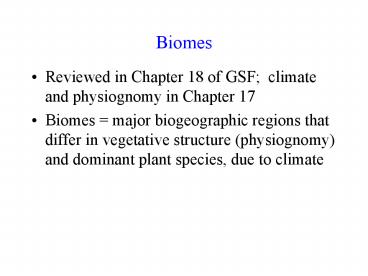Biomes PowerPoint PPT Presentation
1 / 34
Title: Biomes
1
Biomes
- Reviewed in Chapter 18 of GSF climate and
physiognomy in Chapter 17 - Biomes major biogeographic regions that differ
in vegetative structure (physiognomy) and
dominant plant species, due to climate
2
Biomes Fig 18.1
3
Surface Air Circulation (fig 17.7)
4
How updrafts and downdrafts (Hadley Cells)
affect vegetation
5
An Idealized Continent
Band of forest in wetter area, 50-60 north
Rainforest at Equator
Deserts at 20-30 north and south
6
Biome distribution fig 18.2
7
Biomes and climate
- Latitude, altitude, topography/location in land
mass all affect local climate - In North America, North/South is mostly
temperature, East/West is mostly
precipitationbut not completely
8
The Biogeoclimatic Zones of BC
http//www.for.gov.bc.ca/hre/becweb/
9
Biogeoclimatic Ecosystem Classification
BEC zones
- Developed by V. J. Krajina of UBC in the 1960s
- 14 Biogeoclimatic zones named for BC, reflecting
variation in topography, climate, soils, and
resulting vegetation
10
Biogeoclimatic Ecosystem Classification
BEC zones
- BEC groups ecosystems at three levels
- Regional vegetation, soils, topography used to
infer climate over uniform regions - Local site units with relatively uniform
vegetation - Chronological based on history and seral stage
(not really used much)
11
Biogeoclimatic Ecosystem Classification
BEC zones
12
BEC zones
BEC names
- Zones named for dominant species or vegetation
type Coastal Western Hemlock Zone, Bunchgrass
zone - Subzones are based on differences in
precipitation and relative temperature and
continentality - Variants given geographic names, depending on
where they occur - Site series based on relative soil moisture and
nutrient availability
13
BEC zones
BEC Why?
- When site limiting factors inferred via BEC, more
suitable planning for reforestation - Protected area planning
- A common language for forestry, conservation,
land managers in province
14
Species Diversity
15
Patterns and Process of Diversity
- The Niche
- Diversity Gradients
- Local diversity
- Describing diversity
16
What determines the Niche?
The Niche
- Conditions
- Resources
- Limiting Factors
17
Condition/Resource Response Curves
The Niche
Repro possible
Reproduction
Growth
Performance
Survival
Intensity of Condition or Resource
Survival not possible
Examples temperature, pH, water
18
Condition/Resource Response Curves
The Niche
- Other potential shapes
Lethal at high value Resource essential for
growth
19
A graphical representation of the niche
The Niche
20
Diversity and the Niche
The Niche
- Ultimately, diversity (species richness) depends
on how many species can survive the limits of
conditions for growth and reproduction, and all
necessary resources
21
Important Niche Concepts(that you should be
familiar with already)
The Niche
- Fundamental vs. realized niche
- Niche breadth
22
Diversity gradients
Diversity Gradients
- Elevation
- Santa Catalina Mountains
Boreal Forest
Desert
Fig 19.2
23
Diversity gradients
Diversity Gradients
- Position in continental landmass
- Spruce communities in Canadian boreal forest
Bars with different capital letters indicate
statistically significant differences among
regions within community types. Bars with
different small letters indicate statistically
significant differences within regions among
community types.
Fig 19.3
24
Diversity gradients
Diversity Gradients
- Latitude
Crawley, fig 19.1 vascular plant diversity
25
Latitudinal gradient in diversity
Diversity Gradients
- Brazil 56,000 plant species
- United States 18,000 plant species
- Canada 4,200 plant species
- Many hypotheses (see table 19.2), few conclusions
26
Latitudinal gradient in diversity
Diversity Gradients
- Ecological hypotheses (mechanisms of coexistence)
- Evolutionary hypotheses (rates of
diversification) - Historical hypotheses (duration/extent of tropics)
Ecol Lett 10 315-331
27
Latitudinal gradient in diversity Ecological
Hypothesis 1
Diversity Gradients
- Some of the pattern may simply be due to the
limiting factor, temperature - Example distribution of palms (Arecaceae)
28
Latitudinal gradient in diversity Ecological
Hypothesis 1
Diversity Gradients
- Some taxonomic groups (e.g. pines in North
America) show a different pattern of
diversitydifferent temperature limits
29
Latitudinal gradient in diversityEcological
Hypothesis 2
Diversity Gradients
- Coexistence due to relationship between
productivity and niche breadth?
30
Latitudinal gradient in diversity Ecological
Hypothesis 2
Diversity Gradients
- Niche breadth arguments may be related to
dominance-diversity relationships (i.e. trees)
31
Latitudinal gradient in diversityEcological
Hypothesis 3
Diversity Gradients
- Higher productivity ? more species, larger
population sizes, less extinction - Some combination of the three ecological
hypotheses accounts for a large amount of the
gradient (but not all)
32
Latitudinal gradient in diversityEvolutionary
Hypothesis
Diversity Gradients
- In tropics, biotic interactions prevail in
temperate areas, abiotic factors prevail - Abiotic factors dont evolve, but are fixed
physiological targets biotic interactions do
evolve selection for diversification
33
Latitudinal gradient in diversityGeographic
Hypothesis
Diversity Gradients
- Combines ecological and evolutionary viewpoint
- Landmass in tropics is larger, and area somewhat
less affected by glaciation events, so greater
diversity due to species/area relationship - Larger land area and longer time periods since
glaciation allow for more speciation, more
colonization, and adaptation of colonists (more
time for evolution) - Evidence? tree species richness in high latitude
forests has been increasing over last 10,000
yearspost glaciation northward colonization?
34
Latitudinal gradient in diversitysummary
Diversity Gradients
- Productivity is widely recognized as the most
important mechanism - Some support for importance of
- Habitat size and heterogeneity
- Biotic interactions (competition, herbivory)

